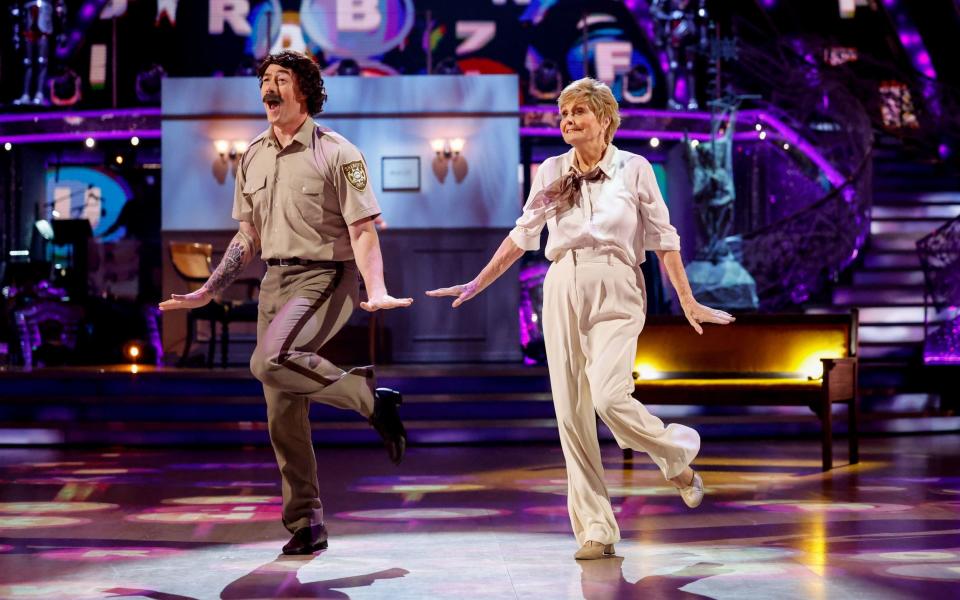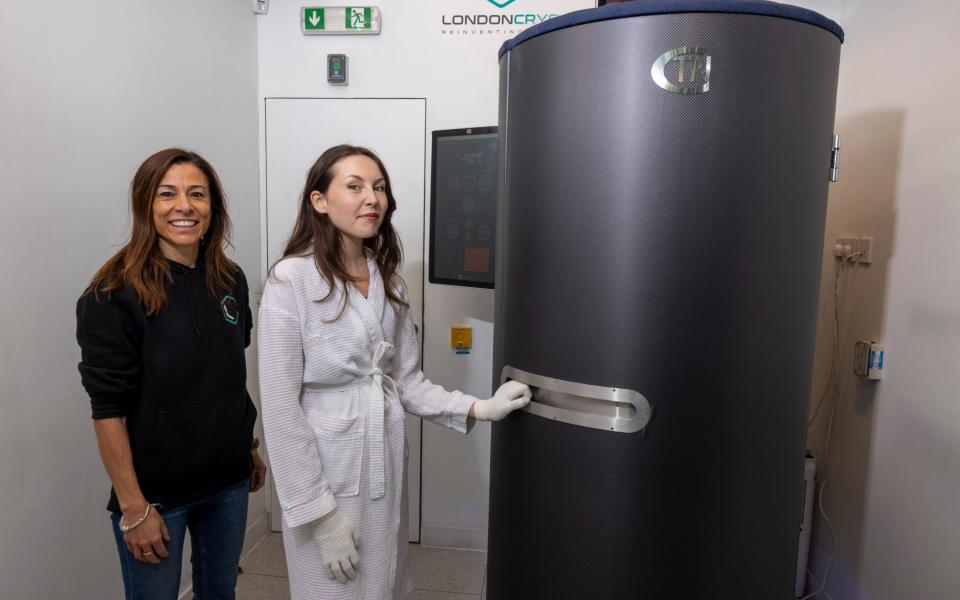The surprising health benefits of sub-zero temperatures

I may as well be about to submerge myself in a giant bag of frozen peas. In front of me is an ominous tube that has been programmed to a temperature of -120C, which I am to stand inside of, for two minutes. As the door opens, bellowing plumes of nitrous oxide, I wonder what I’ve let myself in for - but if Strictly’s Angela Rippon willingly entered it twice a week, while she was on the series, and hasn’t seemingly turned into a freeze-dried blueberry, then I’m game.
I’m on a visit to LondonCryo in Belgravia where, for the first time, I am to experience whole body cryotherapy: the practice of exposing your mostly naked body to subzero temperatures in the pursuit of improved circulation, mental clarity and relief from joint and muscle pain. It is this treatment that Rippon, 79, credits with having kept her injury-free throughout her time on the popular BBC show. “I know I’ve got to keep my body strong,” she said at the time, “so when we finish, I’m having cryotherapy.”

When LondonCryo opened in 2017, its offering was niche, sought by the professionally athletic or exuberantly wealthy. Since then, the clinic has treated more than 20,000 patients from “all walks of life”, founder Maria Ensabella says – Rippon among them.
The practice has long been used by sports stars for boosting post-workout recovery; boxer Floyd Mayweather and Brazilian footballer Neymar have been fans for years. Other celebrities who have used the therapy include Idris Elba and Carol Vorderman while Cat Deeley claims that the procedure alleviated her long Covid symptoms, ranging from aches and pains in her hands, to a “fuzzy feeling” in her neck.
“Cryotherapy was first popular with athletes, but many ordinary people come in for pain relief as they’re dealing with conditions like fibromyalgia, Parkinson’s and arthritis,” says Ensabella, who brought cryotherapy to Britain after seeing its popularity in New York, where she lived. Ensabella does not make any claims to this being a “miracle cure”, though she has “certainly seen that it can help some people to manage their pain, sometimes more than anything else that they have tried”.
I am fortunate not to have long Covid, and being 50 years younger than Angela Rippon, I don’t often experience joint pain or stiffness. So I am more interested in cryotherapy’s supposed collagen-boosting properties and slimming effects (the treatment boosts your metabolism, Ensabella says). Having done strenuous leg exercises at the gym the previous morning, I’m hoping it might work out some tension, too.

So, to the tube. Its padded insides give it the appearance of a weird science-fiction coffin (indeed the liability waiver I’ve just signed warns me not to huff the fumes lest I might die. Reassuring). I step up to the platform, which is height-adjusted to allow my head and shoulders to poke out of the top. Once the door is re-sealed, that is when the cold hits – and hit it does, like being pelted with snowballs for a full 120 seconds.
To offset some of the shock factor, Ensabella has me turn around inside the tube, a bit like I’m a hog roast. (A cold one.) After 60 seconds I’m flooded with adrenaline, feeling the instinct to climb out. That’s my fight or flight response, Ensabella says.
“Temperatures of –110C or less trigger that survival response as your body believes it’s going to go into hypothermia,” she explains. “Your blood then rushes to your core because it wants to protect your organs. At that point it oxygenates your blood, replenishing nutrients and flushing out toxins.”

The adrenaline makes the two minutes pass surprisingly quickly, and before I know it my time is up. Coming out of the tube I feel invigorated, my energy levels definitely seem boosted. No, I haven’t instantly shed 10lbs, but that night my appetite is roaring, a sign my metabolism has been kicked into action.
“Even from a single session, everybody gets a good night’s sleep after cryotherapy,” Ensabella promises. She’s right.
But does it work ...
My post-gym muscle pain has seen no improvement but for that I only have myself to blame, according to Dr Adnan Haq, a lecturer in sport and exercise science at the University of South Wales. Dr Haq spent six years evaluating the effects of whole body cryotherapy, so he has seen first hand whether this trendy new treatment can do any serious good.
“Many sportspeople do cryotherapy to reduce their muscle damage and help recovery, “ says Dr Haq.
He suggests it’s done “as soon after exercise as possible, ideally within 30 minutes and certainly before an hour has passed”.
In one study Haq led they “found that doing cryotherapy more than four hours after a workout was completely ineffective in that regard”.
On that front, some research suggests that ice baths or cold water swimming may be more effective – but like cryotherapy, moderation is key.
“Because cryotherapy helps quicker recovery, it is easier to build muscle as you can then exercise each body part more frequently,” says Dr Haq.
But he also warns: “There is also evidence to suggest that too much cryotherapy is a bad thing for muscle growth, which makes sense when you consider the fact that cold temperature restricts blood flow, meaning that your muscles don’t receive the supply of amino acids that they need to get bigger.”
What about Cat Deeley’s claims that regular cryotherapy has helped her to live with long Covid?
“One of my clients with long Covid has incorporated cryotherapy into her lifestyle,” says Ensabella. “She’s seen a huge increase in the amount she can get done, so it really has helped transform her health.”

Dr Haq isn’t so sure, having never led a trial that studies the effects of cryotherapy on long Covid.
“In my opinion there just isn’t enough evidence yet to support using cryotherapy to treat long Covid,” he says.
However, there has been limited research on effects of whole body cryotherapy on lung function he says.
“There could be a positive trend towards better increased lung capacity, and breathing function, perhaps due to decreasing lung inflammation,” he says.
So, for those of us without a serious illness, does cryotherapy live up to the hype? I’m lucky to have received a complimentary session, but at £99 a time (or £499 for 10 sessions) I’m not sure it’s something I’d pay for – mostly because I have no ambition to become a bodybuilder, and as a 20-something might not be able to fully appreciate this treatment’s benefits.
“People who are in their 70s might get more out of cryotherapy as they’re highly likely to have more inflammation that can be relieved,” says Ensabella, “but those people usually would need to come in for regular sessions, rather than one-offs, as our younger athlete clients sometimes prefer.”
The jury is out on that, however.
“Older people might benefit a bit less from cryotherapy because with age, our blood vessels start responding more slowly to temperature changes,” says Dr Haq. “I certainly wouldn’t dissuade older people from trying it out, though.
“In the trials I’ve conducted, I’ve seen first hand how it can benefit people with Parkinson’s or other conditions or [those] who struggle with movement-related pain in general.
“Then there’s the rejuvenation effect and the mood boost that lots of people feel,” Dr Haq adds. “If you find that cryotherapy has more benefit to you than a massage of the same cost, then it might be worth the price tag.”
As I leave LondonCryo I take a wistful look over at the clinic’s infrared sauna, the second component in Cat Deeley’s long Covid treatment regime (and the more comfortable experience of the two I’d guess). It seems that cryotherapy is a wellness trend that’s here to stay, but I know where I would rather spend a Sunday morning.


